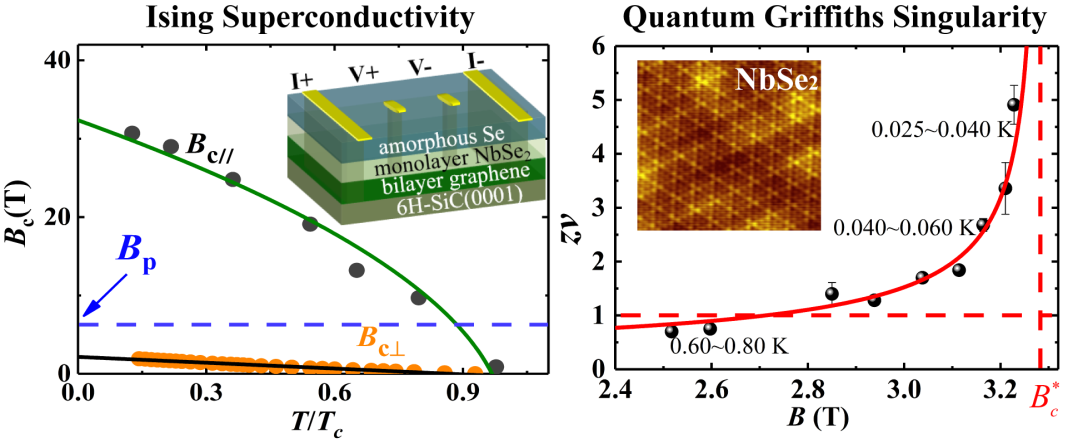Nano Letters publishes Jian Wang research group and collaborators’ work on the coexistence of Ising superconductivity and quantum Griffiths singularity in macro-size monolayer NbSe2
Two-dimensional (2D) transition metal dichalcogenides (TMDs), regarded as the materials beyond graphene, have become a hot research topic due to a range of unique physical properties and potential applications of electronics, photonics, spintronics, and quantum computing devices. In previous reports, the mechanical exfoliation technique of micro-size TMD flakes has attracted particular interest on account of its simplicity and cost effectiveness. However, for most applications, high quality larger area crystalline films are preferred. Therefore, the preparation of high quality macroscopic area ultra-thin TMDs is highly desired in this field.
A recent review paper points out three major topics in 2D superconductors filed (Nat. Rev. Mater. 2, 16094 (2016)): quantum metal, quantum Griffiths singularity (QGS) and Ising superconductivity. In 2015, Jian Wang group and collaborators firstly reported the QGS in 2D and superconducting system (3 atomic layer Ga films, Science 350, 542(2015), Science 350, 509 (2015)), with the divergence of the dynamical critical exponent when approaching the zero temperature quantum critical point. Then they confirmed QGS in superconducting LaAlO3/SrTiO3(110) interface (PRB 94, 144517 (2016)). Theoretically, when the spins of the superconducting pairing electrons are strongly pinned by an effective Zeeman field, the superconductivity can survive in an ultrahigh external in-plane magnetic field far beyond the Pauli paramagnetic limit, which is named as Ising superconductivity. Experimentally, in both gating MoS2flakes and NbSe2 flakes, Ising superconductivity was reported. Verifying QGS in Ising superconductors would not onlydemonstrate the universal property of QGS but also help tounderstand the underlying mechanism of the 2D superconductors where Ising superconductivity and QGS coexist.
Recently, Prof. Jian Wang at Peking University and Prof. Shuaihua Ji at Tsinghua University, in collaboration with Prof. Xi Lin, Prof. Ji Feng at Peking University, Prof. Qi-Kun Xue, Prof. Xi Chen at Tsinghua University, Prof. Mingliang Tian, Dr. Chuanying Xi at Heifei High Magnetic Field Laboratory of the Chinese Academy of Sciences, as well as Prof. Haiwen Liu at Beijing Normal University systematically studied macro-size (on the order of mm2) atomically flat monolayer NbSe2 films (only 0.6 nm thick) with Se protection layer grown on bilayer graphene terminated surface of 6H-SiC(0001) substrates by molecular beam epitaxy(MBE) method. The films exhibit an onset superconducting critical transition temperature above 6 K and the zero resistance superconducting critical transition temperature up to 2.40 K. The superconductivity is better than that of mechanical exfoliated monolayer NbSe2 flakes and MBE grown monolayer NbSe2 films in previous reports. Simultaneously, ultrahigh magnetic field measurements show that the extremely high parallel upper critical field Bc2// (T = 0) significantly exceeds the Pauli paramagnetic limiting field, consistent with Zeeman-protected Ising superconductivity. In this work, Bc2//(0) > 5Bp as T/Tc down to 0.13 is firstly demonstrated by high magnetic field up to 35 T and low temperature down to 0.35 K, other than data fitting extrapolation. Besides, by ultralow temperature and perpendicular magnetic field electrical transport measurements, the monolayer NbSe2film shows the signature of QGS when approaching the zero-temperature quantum critical point. This is the first report of coexistence of two important quantum behaviors, Ising superconductivity and quantum Griffiths singularity, in superconductors at 2D limit.
The paper was published online on Nano Letters on October 10, 2017. (DOI: 10.1021/acs.nanolett.7b03026, http://pubs.acs.org/doi/10.1021/acs.nanolett.7b03026)
Prof. Jian Wang at Peking University and Prof. Shuaihua Ji at Tsinghua University are corresponding authors of this paper. Dr. Ying Xing at China University of Petroleum-Beijing and Dr. Kun Zhao at Tsinghua University contributed equally to this work.
This work was supported by the National Basic Research Program of China, the National Natural Science Foundation of China, the Research Fund for the Doctoral Program of Higher Education of China, the Open Research Fund Program of the State Key Laboratory of Low Dimensional Quantum Physics, Tsinghua University, the Open Project Program of the Pulsed High Magnetic Field Facility, Huazhong University of Science and Technology and the Science Foundation of China University of Petroleum, Beijing.
Figure Left: The characteristic magnetic field Bc for both perpendicular and parallel fields. The large parallel characteristic field Bc// provides the direct evidence of Ising superconductivity. The inset depicts the schematic diagram for heterostructure and standard four-probe configuration for electrical measurements. Right: superconductor-metal transition exponent zν as a function of magnetic field, diverges at critical point, provides the direct signature of quantum Griffiths singularity. The inset is atomic-resolved STM image on monolayer NbSe2 film.
